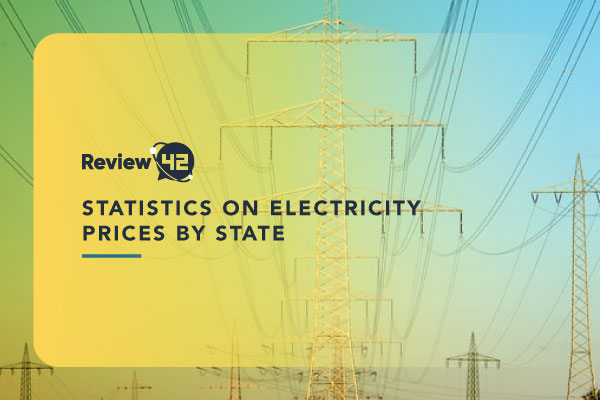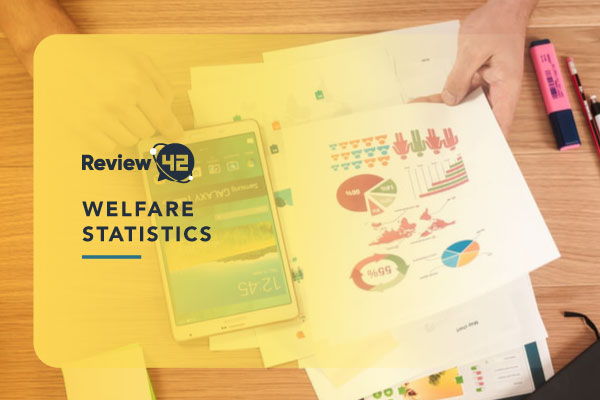Student Loan Debt Statistics [2024 Numbers & Facts]
 Fact-checked
Fact-checked
Last Updated: February 13, 2024
College Student Debt Statistics
Federal Student Loan Debt Statistics
Private Student Loans Debt Statistics
Student Loan Repayment Status
Delinquencies
Student Loan Debt by Age
Student Loan Debt by Gender
Average Student Loan Debt at Top 20 Universities in the US
Average Student Debt by State
Other Student Loan Debt Statistics
Impact of the COVID-19 Pandemic on Student Loan Debt
Wrap Up
Millions of Americans are repaying student debts even during the pandemic. In 2021 and the upcoming years, we expect student loan debts to continue growing. In this article, we take a look at important student loan debt statistics to see big-picture trends.
This article gathers the most important data from various sources like government websites and statistics agencies. Read on to see how the COVID-19 pandemic affected the nation’s student loan debt numbers.
Student Loan Debt Statistics – Editor’s Pick
- US students owed nearly $1.6 trillion in student debt in 2020.
- Aggregate student loans could reach $3 trillion by 2038.
- Around 44 million Americans have student loans.
- 92% of student loans are federal loans.
- 56.65% of all federal student loans are in forbearance until September 2021.
- The annual growth rate of student loan debts is 513% faster than the US GDP growth rate.
College Student Debt Statistics
1. Among their borrowing options, people choose student loans more frequently than others, although some also choose great credit cards for students as a method of funding.
(Federal Reserve Report)
2. The New York Fed statistics of student loan debt show the average debt in 2020 exceeded $37,500. Around 54% of college students took on debt in 2020 to pay for education; the total sum amounted to $1.6 trillion.
(Federal Reserve of New York)
3. If the current trends continue, the total outstanding student loan debt will reach $3 trillion by 2038.
(SavingForCollege)
This rising trend in statistics about student debt reinforces a decades-long pattern. In 2010, student loan debt exceeded credit card debt, hitting the $1 trillion mark in 2012.
4. In the 2019/2020 academic year, $102 billion was offered in student loans by different sources to students across the US.
(Statista)
This included loans from states and institutions as well as private loans from banks, credit unions, and others. Other financing options from these sources include secured credit cards.
5. How many students have taken out student loans? The answer is a staggering 44 million — about one in every eight Americans — and that number rises every year.
(Federal Student Aid)
Federal Student Loan Debt Statistics
6. Around 92% of all student loans come in the form of federal loans or loans given by the US Department of Education.
(MeasureOne)
7. College students debt statistics show 43 million people owe money on federal student loans.
(MeasureOne)
Around 34.5 million borrowers owe $1.16 trillion in direct loans, while 2.2 million borrowers owe $6.9 billion in Perkins Loans. These loans are offered for people who want to fund their undergraduate education, graduate students, as well as the parents of college students.
Around 45.3 million students have an average of $35,510 in federal loans. Meanwhile, 30% of undergraduates borrow money from the federal government, 52.8% of which are in Stafford Loans.
8. College debt statistics show that 18.6% of all federal loan debts are subsidized Stafford loans, while 34.2% are unsubsidized.
(EducationData)
Overall, the federal government loans an average of $45.3 billion annually to 44.4% of all post-secondary education students.
Private Student Loans Debt Statistics
9. Private loans are financing options to supplement federal education loans. These loans typically come from banks, credit unions, or a school.
(EducationData)
Of the total student loan debts in the US, 8.4% are in private student loans. Nearly 13% of students use private student loans to finance their education.
10. According to statistics on college debt, America’s national private student loan balance is around $137 billion. Roughly 88.5% is spent on undergraduate loans, while 11.5% goes to graduate loans.
(EducationData)
Student Loan Repayment Status
11. Forbearance suspends payments for 12 months during financial troubles.
(EducationData)
Borrowers are responsible for the interest accrued during the forbearance period. Deferment is considered better since borrowers don’t have to pay accrued interest. Between last year’s 2nd and 3rd quarters, the average college students’ debt in repayment decreased by 82%. However, between the 3rd and 4th quarter, that number grew by 33.3%.
12. At present, there are around 400,000 — or only 0.88% of the total number — of federal student loans are in repayment.
(EducationData)
13. That is a 97.8% decrease from the 2nd quarter of 2020 when 40.1% of borrowers were in repayment.
(EducationData)
14. Roughly 56.65% of federal loans are in forbearance, and they’ll remain so until September 2021.
(EducationData)
15. College student loan debt statistics show that there are currently 3.1 million federal loan borrowers who have deferred payments.
(Federal Student Aid)
There were 3.4 million federal student loans in deferment during the first quarter of 2019.
16. Prior to the COVID-19 pandemic, US student loan debt statistics showed that 75.37% of private student loans were being repaid.
(MeasureOne 2019)
Almost 1.5% of these were 90 days past due, however.
17. With private student loans, the borrower is accountable for accrued interests in both forbearance and deferment.
(MeasureOne 2020)
In Q1 of 2020, around 20.39% and 5.16% of private student loans were in deferment and forbearance, respectively.
College student debt statistics also revealed that although more private loans were in repayment than federal loans, the percentage of repayments that were 90 days past due was higher at 1.10%.
18. By contrast, 18.6 million borrowers are paying their loans on time, with many of them using student loan refinancing.
(MeasureOne 2020)
Delinquencies
Federal loans that aren’t paid on time don’t go automatically into default for 270 days. They’re considered delinquent at first.
There’s a downtrend in delinquencies and defaults.
19. According to data, a student borrower attending for-profit private colleges is more likely to default.
(EducationData – Student Loan Default)
Around 10.8% are likely to default within their first repayment year, while 25% usually default within their first five years. Some of them find great student loan refinance companies to help them.
20. According to the American student loan debt statistics, only 3% of student loan payments are 90 days delinquent but not in default.
(EducationData – Student Loan Default)
21. Around 38%–39% of people with college loans between 2012 and 2017 didn’t finish college, according to the latest available data.
(WRAL)
Student Loan Debt by Age
22. Around 34% of people aged 18–29 have student loans. Borrowers under 24 owe an average of $16,500.
(EducationData – Student Loan by Age)
With the total student loan debt in the US for this group, they also more frequently search for loans that require no credit history.
The average amount owed by 35-year-old adults is $42,600. Those between 30 and 60 years old have average loan debts higher than the national private student loan balance.
23. Around 5.2 million adults in their 50s have student loan balances.
(EducationData – Student Loan by Age)
Only 2.8 million adults in their 60s have such debts.
24. Data on the average student loan debt by age show that adults carry most of the student debts, with those aged between 35–49 carrying $602 billion in balances.
(Federal Student Aid)
Those between the ages 25–34 carry $500 billion in federal student loan debt.
Student Loan Debt by Gender
Women owe $929 billion of the total national student loan debt amount. The most commonly cited reason behind this is the persistent gender wage gap.
25. Despite having a lower income, women (54%) make higher student loan payments than men (51%).
(AUUW.Org Report)
This also means that women have a higher average student loan debt per person than men.
26. A huge majority (67.2%) of female students get federal loans, while 24.2% get private loans.
(EducationData – Student Loan Debt by Gender)
27. The same is true for males: 55.9% of men receive federal loans, while 21.5% receive non-federal loans.
Around 70% of females with associate degrees received student loans, while only 55.9% of males with associate degrees receive such loans.
(EducationData – Student Loan Debt by Gender)
Average Student Loan Debt at Top 20 Universities in the US
Here’s a list of the top US universities with their corresponding average college students debt.
| University (Rank) | Average Student Loan Debt |
| Princeton University (1) | $9,445 |
| Harvard University (2) | $16,130 |
| Columbia University (3) | $27,595 |
| Massachusetts Institute of Technology (3) | $23,517 |
| Yale University (4) | $15,379 |
| University of Chicago (6) | $26,619 |
| Stanford University (6) | $22,897 |
| University of Pennsylvania (8) | $23,009 |
| Johns Hopkins University (9) | $24,107 |
| Northwestern University (9) | $36,350 |
| California Institute of Technology (9) | $20,192 |
| Duke University (12) | $22,203 |
| Dartmouth College (13) | $25,071 |
| Brown University (14) | $24,304 |
| Vanderbilt University (14) | $22,727 |
| Rice University (16) | $24,292 |
| Washington University in St. Louis (16) | $24,247 |
| Cornell University (18) | $27,094 |
| University of Notre Dame (19) | $27,460 |
| University of California – Los Angeles (20) | $21,441 |
Average Student Debt by State
Here’s a breakdown of the average student debt by state.
(AdvisorSmith)
| State | Average Student Loan Debt | State | Average Student Loan Debt |
| District of Columbia | $55,400 | Louisiana | $34,400 |
| Maryland | $42,700 | Arizona | $34,100 |
| Georgia | $41,500 | Massachusetts | $34,100 |
| Florida | $39,700 | Nevada | $33,600 |
| Virginia | $39,000 | New Mexico | $33,600 |
| South Carolina | $38,300 | Alaska | $33,600 |
| New York | $37,800 | Minnesota | $33,400 |
| Illinois | $37,600 | Arkansas | $33,300 |
| North Carolina | $37,500 | Montana | $33,300 |
| Alabama | $37,100 | Indiana | $32,800 |
| Delaware | $37,000 | Texas | $32,800 |
| Oregon | $36,900 | Idaho | $32,600 |
| Vermont | $36,700 | Kentucky | $32,500 |
| Mississippi | $36,700 | Kansas | $32,500 |
| New Hampshire | $36,700 | Maine | $32,500 |
| Hawaii | $36,500 | Utah | $32,200 |
| California | $36,400 | Nebraska | $32,100 |
| Tennessee | $36,200 | Rhode Island | $31,800 |
| Michigan | $35,900 | West Virginia | $31,800 |
| Colorado | $35,800 | Wisconsin | $31,800 |
| Missouri | $35,400 | Oklahoma | $31,500 |
| Pennsylvania | $35,400 | South Dakota | $31,100 |
| New Jersey | $35,100 | Wyoming | $31,000 |
| Washington | $35,000 | Iowa | $30,500 |
| Connecticut | $34,900 | North Dakota | $29,200 |
| Ohio | $34,600 |
Other Student Loan Debt Statistics
28. The highest-income households hold 60% of the total student loan debt in America, and they make nearly three-quarters of all payments.
(Federal Reserve Consumer Finances)
29. About 42% of students finish their studies without any debt, thanks to education funding alternatives, such as credit cards for young adults.
(APLU)
30. The annual growth rate of the country’s student loan balance is 23.6% or 513% faster than the annual GDP growth rate, which is 3.85%.
(EducationData)
31. Further, 52% of students with outstanding student loans don’t feel it was worth it. Many of them are searching for ways to buy homes even with bad credit, but their outstanding loans render them unqualified.
(EducationData)
Impact of the COVID-19 Pandemic on Student Loan Debt
32. During the pandemic, the average private student loan debt was 20% deferred and 75% in repayment.
(EducationData)
Due to the COVID-19 situation, many private student loan lenders offered a three-month suspension of payments, which partly helped many get out of debt fast. However, few of them deferred interest rates accrued during that period.
33. Between the second and third quarters of 2020, the CARES Act offered debt relief to at least 20 million borrowers.
(EducationData)
Student loan debts in repayment decreased by 82%. Those in forbearance increased by 375%. As a side effect of the legislation, many borrowers saw their previously bad credit scores become better.
Wrap Up
The trends are easy to spot when it comes to knowing how many students are in debt, with the overall direction going up. Even before the pandemic, student loan debts have been rising, with minimal movement in terms of repayment.
With the COVID-19 pandemic still ongoing, the US government is enacting legislation that may impact the long-term trend of such debts. It’s highly likely that we’ll see the general trend continue.
FAQ
One in every eight Americans has student loan debt, which is equivalent to about 44 million people. Around 92% of all student loans come in the form of federal loans, while 8.4% are in private student loans. There are around 400,000 federal student loans are in repayment.
According to the New York Fed, the average student loan debt exceeded $37,500 in 2020. The average amount owed by 45.3 million students with federal loans is around $36,510. The federal government loans an average of $45.3 billion annually.
The highest-income households hold nearly 60% of the total student loan debt in America. Of the total national student loan debt amount, around $929 billion are held by women, according to student loan debt statistics.
Sources
- Federal Reserve
- Federal Reserve of New York
- SavingForCollege
- Statista
- Federal Student Aid
- MeasureOne2019
- EducationData
- MeasureOne 2020
- EducationData - Student Loan Default
- WRAL
- EducationData - Student Loan by Age
- AUUW.Org Report
- EducationData - Student Loan Debt by Gender
- AdvisorSmith
- EducationData - Student Loan Debt by State
- Federal Reserve Consumer Finances
- APLU
- EducationData - Average Time to Repay Student Loans
2 Comments
Leave a Reply
You must be logged in to post a comment.
![How Many Marriages End in Divorce [Fascinating Facts and Stats]](https://review42.com/wp-content/uploads/2022/07/How-many-marriages-end-in-divorce.png)
![How Much Do Flight Attendants Make? [Latest Data for 2024]](https://review42.com/wp-content/uploads/2022/06/feature-image-56-how-much-do-flight-attendants-make.jpg)
![What Is a Bridge Loan? [Ultimate Guide for 2024]](https://review42.com/wp-content/uploads/2022/06/feature-image-55-what-is-a-bridge-loan.jpg)
![How Many Websites Are There? [2024’s Data]](https://review42.com/wp-content/uploads/2022/05/feature-image-55-how-many-websites-are-there.jpg)
![Do You Have to Pay Taxes on Inheritance? [Full Guide]](https://review42.com/wp-content/uploads/2022/04/feature-image-53-do-you-have-to-pay-inheritance-taxes.jpg)

![Average Gas Prices by State in the US [2024 Data]](https://review42.com/wp-content/uploads/2022/03/feature-image-51-average-gas-price-by-state.jpg)

![How Long Does It Take To Buy a Car? [All Steps Explained]](https://review42.com/wp-content/uploads/2022/03/feature-image-50-how-long-does-it-take-to-buy-a-car.jpg)

vreyrolinomit
April 14, 2021 at 5:33 pm
Hi my family member! I want to say that this article is amazing, nice written and include almost all significant infos. I¦d like to see more posts like this .
soundos
December 29, 2021 at 10:43 am
great blog for sharing!!!!